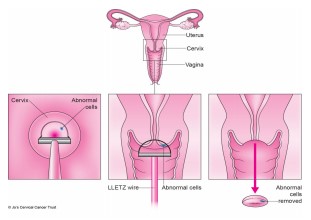Colposcopy Treatment (Loop Excision) Your Aftercare
Please note, this page is printable by selecting the normal print options on your computer.
What is Colposcopy?
Colposcopy is a simple examination that allows the doctor to see the type and area of the abnormality on your cervix. It also lets the Colposcopist (either a doctor or a nurse) decide if you need treatment or management.

Large Loop Excision of the transformation Zone (LLETZ)
This is the preferred treatment now. It can be used to get tissue for biopsy (sample) or to carry out full treatment. It is done with a thin heated wire in the shape of a loop. You may be aware of the anaesthetic being injected. The treatment only takes a few minutes.

Following your LLETZ treatment, you need to take care to allow your cervix to heal as quickly as possible. The aftercare advice that follows will speed your recovery.
To reduce the risk of infection & promote healing:
• You should rest and take the remainder of the day off work
• No sexual intercourse for at least 4 weeks.
• You will have a discharge for anything up to 4 weeks. This is normal; it may be like a period or just a watery discharge with black specks. Do not use tampons whilst any discharge continues, or for the next period. If bleeding becomes heavy and/or you are passing clots, contact us or your GP as soon as possible as this may indicate an infection.
• You may travel following treatment but your travel insurance may not cover any complications
• Light exercise is fine but do not swim for 2 weeks
• You may shower as usual, but do not linger in the bath or add bubbles.
• If your coil was removed prior to treatment, it may be replaced by your GP six weeks later.
• You will receive your results in up to 2 to 6 weeks. If results not received by this time, contact the Colposcopy Department.
Discomfort after treatment
A few women experience period type cramps in the first few days after treatment. ‘Off the shelf’ pain relief should be taken if you experience any discomfort.
Will the treatment work?
You will receive your results by letter and this will contain your follow-up plan. In the majority of cases one treatment is sufficient to return smears to normal, thereby removing the possibility of reducing cancer in the future. Cancer of the cervix normally takes many years to develop. The purpose of having cervical smears at least every 3 years is to detect abnormal cell changes at a stage
when they cause no symptoms and can be treated easily.
At present it is not possible to predict what will happen in the case of each woman. However, early treatment is generally successful and complications are minimal. LLETZ does not appear to cause infertility but may increase the risk of early labour.
Will I need any follow-up treatment?
You will have a check, a smear and Human Papillomavirus (HPV) test with your GP in six months. This is to check the treatment has been effective. If all is normal at this stage, you will be
informed when your next smear will be due, most likely in 3 years. If the smear is negative, borderline or low grade but if the HPV is negative, then you will be returned to normal recall. However, if your smear is negative, low grade or borderline but the HPV test is positive you will be recalled to Colposcopy for examination.
Please remember:
It is important to keep all further appointments after a biopsy or treatment. If you are concerned in any way following your treatment, please contact:
One of the team Monday – Friday between 9 – 5pm 01908 996318 (secretary) 01908 995223 (Nursing Office) (This service is not available on Thursday).
Out of hours contact your GP.
References
NHS Cervical Screening Programme. Colposcopy and Programme mgt. Pub: NO.20, 3rd ed, March 2016 NHS Cervical screening: Having a Colposcopy 2012
